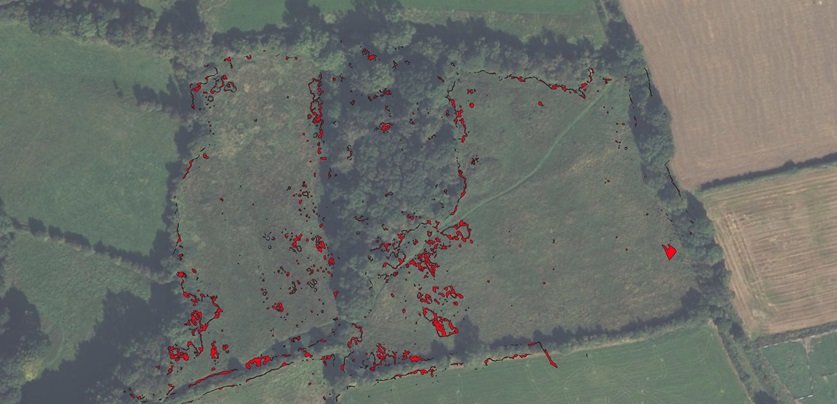Reflections on my one-year traineeship with NEYEDC
Rob has been employed on a one-year traineeship with NEYEDC since November 2023, giving him experience of the day-to-day running of a Local Environmental Records Centre (LERC). The opportunity to become a trainee became available after NEYEDC’s existing trainee, Seebra, successfully applied for the role of Ecological Data Officer (Local wildlife Sites) within the organisation. Seebra wrote last year when she started at NEYEDC how the traineeship had helped her to gain a first job in the often-competitive ecological sector. Approaching the end of his traineeship, Rob reflects on his year with NEYEDC.
I first met NEYEDC in October 2021 at an event at the Merchant Adventurers' Hall in York where the wildlife author Dave Goulson was giving a talk on insect declines. I’d just started the second year of my BSc in Environmental Geography at York St John University and after a couple of conversations with the team they kindly agreed for me to complete a work placement with them as part of an upcoming Professional Practice module.
Chocolate-tip moth (Clostera curtula), trapped and released from my DECIDE moth trap
Rather than just being the ‘tea boy’, I felt fully integrated into the organisation with my own work plan and pieces of real-world project work such as mapping for the North Yorkshire Turtle Dove Project and tidying of species record datasets prior to entering NEYEDC’s records database. I was also introduced to world of moth trapping through the CEH DECIDE moth trapping project.
Having become interested in NEYEDC’s drone (UAV) work during my placement, I wanted to see whether I could explore the use of drones and photogrammetry further in my final year dissertation project, and again NEYEDC kindly agreed to help. Clare and Mark accompanied me traipsing over the moors of Northumberland to complete the UAV fieldwork and patiently answered questions on how to complete the post-flight processing to create the data outputs.
Mark and Clare were happy to help with Rob's dissertation fieldwork - as long as Rob carried the drone on the 3km walk to the site!
Continuing my interest in how drones can be used as a tool for ecological surveying and monitoring, I undertook training with industry experts Drone Pilot Academy and obtained my A2 Certificate of Competence qualification. I’ve worked with the NEYEDC drone team on their surveys this year being involved in all parts of the process from planning flights, piloting or acting as spotter in the field and then post-processing of flight data.
Most people recognise the ability of drones to obtain images and video, but they are also capable of gathering a whole range of other useful data such as land elevation, tree/vegetation height, NDVI reflectance and thermal imagery (depending on the drone sensor/payload). This is the area that I find exciting because there are a range of applications within ecology and environmental management to which drones can be used to give us new insights.
A recent project I have been working on is to use data we have obtained with the drone to map and quantify the extent of scrub on grassland sites. Mapping scrub by eye in the field can be difficult to do accurately, especially on hilly sites. By using the spot height data to create a canopy height model (CHM), we can identify which areas of the site are scrub and use GIS to measure these and the percentage of the site they cover. The NDVI data we gathered in the same flight also seems to differentiate well between vegetation types so may be incorporated into the mapping of scrub.
Early outputs from the scrub mapping work look promising. Once this process has been further refined it is hoped that this could provide a useful tool to land managers for monitoring scrub extent on grassland sites.
Once this process has been refined, it is hoped that by revisiting these sites in future years and repeating the process we will be able to quantify change over time and help to inform management plans. This has been a satisfying project to work on combining drone post-processing and GIS skills.
Fieldwork and shadowing
Left: Carnation sedge (Carex panicea) seen during a Local Wildlife Site survey. Right: A Great-Crested Newt Egg on aquatic vegetation near the NEYEDC office.
Although most of my time with NEYEDC has been predominately desk-based, I have had several opportunities to improve my field ecology skills. I’ve been able to further develop my interest in botany, attending a vegetative identification of grasses course and shadowing an experienced local wildlife site surveyor assessing a wonderful riverside meadow. Near to our office in Dunnington, there was also the opportunity to shadow a surveyor from the Freshwater Habitats Trust looking for Great-Crested Newt eggs and taking eDNA samples.
A Great Team 😊
Along with these experiences, simply being in an office with colleagues who are passionate about ecology and data, and who are generous in sharing their knowledge has taught me a great deal. It has been a tremendous environment to work in, where no question is too silly, and help is always at hand. I’d like to thank all the staff at NEYEDC for the time, effort and enthusiasm they have put into helping me getting started in my ecology career. I’ll no doubt stay in touch submitting records and hopefully taking part in any future volunteer projects.






